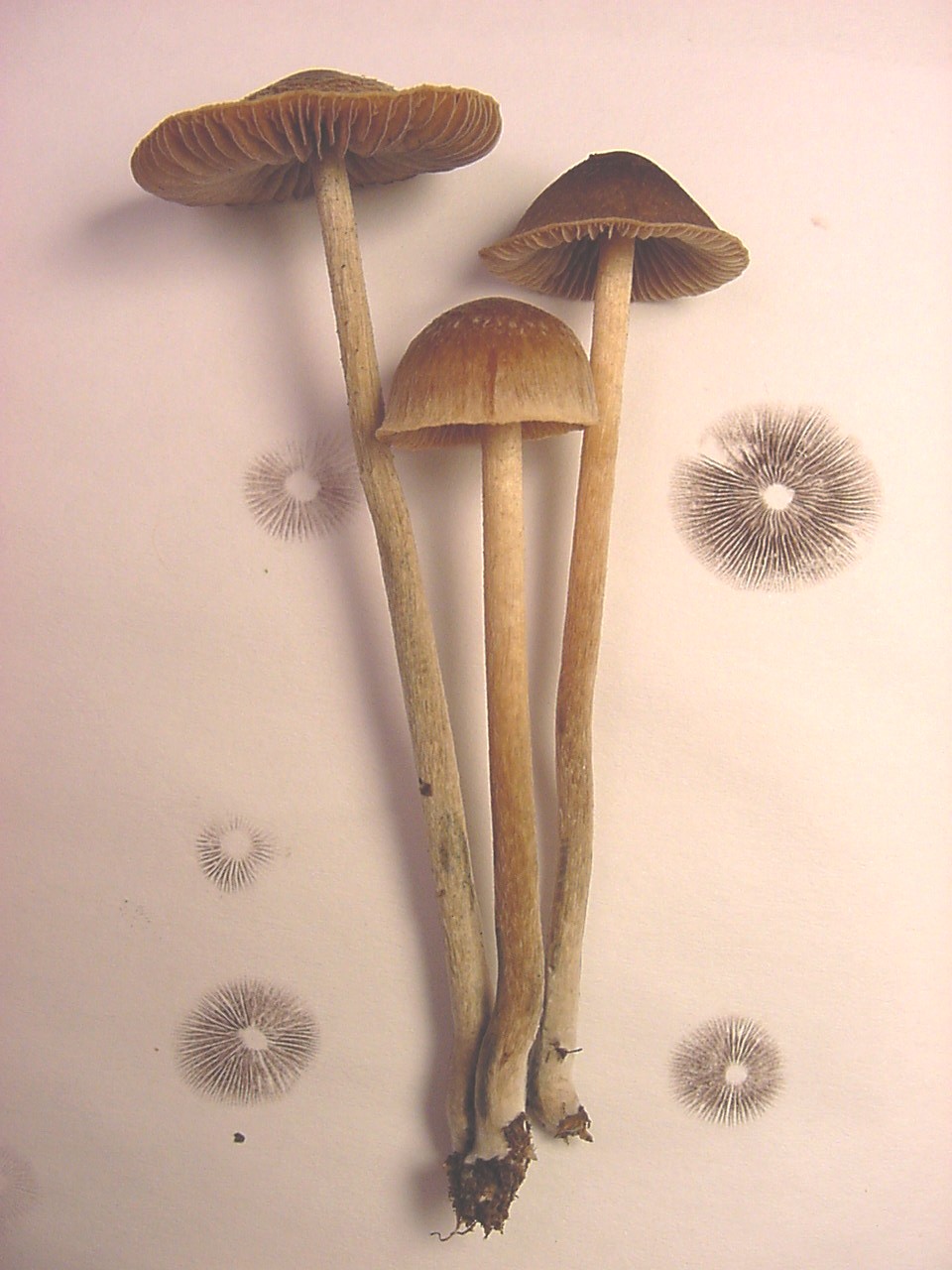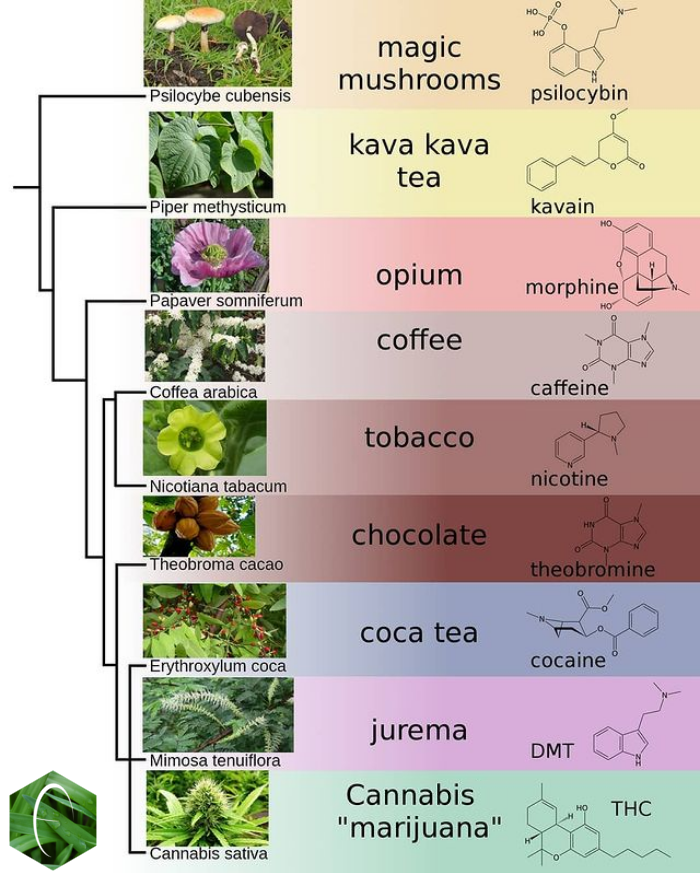|
Psilocybe Mescaleroensis
''Psilocybe mescaleroensis'' is a psychedelic mushroom which has psilocybin and psilocin as main active compounds. This mushroom is closely related to '' Psilocybe hopii'' and '' Psilocybe cyanescens''. It was brought to scientific attention by Lee Walstad. Description *Cap: 2 – 6 cm, convex to subumbonate, brownish-yellow, hygrophanous, margin striate when moist, often with an orangish center, broad umbo and wavy margin. Has a separable gelatinous pellicle. Bruising bluish where damaged. *Gills: Cream color when young, chocolate brown in age, with adnate to adnexed attachment. *Spores: Dark chocolate brown, subrhomboid to subovoid, thick-walled, 9 - 12 x 6 - 8 µm. *Stipe: 5 – 10 cm long, .5 to 2 cm thick, white, sometimes with light orange patches, fibrillose, equal to slightly enlarged near the top. Annulus fragile and membranous, white or dusted with dark brown spores. Stem base with rhizomorphic mycelium. Bluing where damaged. *Taste: Slightl ... [...More Info...] [...Related Items...] OR: [Wikipedia] [Google] [Baidu] |
Gastón Guzmán
Gastón Guzmán Huerta (August 26, 1932 – January 12, 2016), a Mexican mycologist and anthropologist, was an authority on the genus ''Psilocybe''. Career He was born in Xalapa, Veracruz, in 1932. His interest in mycology began in 1955 when as a graduate student he decided to update his school's (National Polytechnic Institute) poorly kept collection of fungi. During his early field work he found a large assortment of species about which little was known at the time. This inspired him to choose fungi as the topic of his professional thesis. In 1957 Guzmán was invited by the University of Mexico to assist Rolf Singer, who would arrive to Mexico the following year to study the hallucinogenic mushroom genus ''Psilocybe''. Guzmán accepted and assisted Singer through his explorations in Mexico. While they were in the Huautla de Jiménez region, in their last day of the expeditions, they met R. Gordon Wasson. For Guzmán it was a "fructiferous meeting." In 1958, he published his ... [...More Info...] [...Related Items...] OR: [Wikipedia] [Google] [Baidu] |
Type Locality (biology)
In biology, a type is a particular specimen (or in some cases a group of specimens) of an organism to which the scientific name of that organism is formally attached. In other words, a type is an example that serves to anchor or centralizes the defining features of that particular taxon. In older usage (pre-1900 in botany), a type was a taxon rather than a specimen. A taxon is a scientifically named grouping of organisms with other like organisms, a set that includes some organisms and excludes others, based on a detailed published description (for example a species description) and on the provision of type material, which is usually available to scientists for examination in a major museum research collection, or similar institution. Type specimen According to a precise set of rules laid down in the International Code of Zoological Nomenclature (ICZN) and the International Code of Nomenclature for algae, fungi, and plants (ICN), the scientific name of every taxon is almost a ... [...More Info...] [...Related Items...] OR: [Wikipedia] [Google] [Baidu] |
Psilocybe
''Psilocybe'' ( ) is a genus of gilled mushrooms, growing worldwide, in the family Hymenogastraceae. Most or nearly all species contain the psychedelic compounds psilocybin and psilocin. Taxonomy Taxonomic history A 2002 study of the molecular phylogeny of the agarics indicated that the genus ''Psilocybe'' as then defined was polyphyletic, falling into two distinct clades that are not directly related to each other. The blue-staining hallucinogenic species constituted one clade and the non-bluing species the other. The previous type species of the genus, ''Psilocybe '' (now Deconica montana), was in the non-bluing clade, but in 2010 the type species was changed to '' P. semilanceata'', a member of the bluing clade. A 2006 molecular phylogenetic study of the Agaricales by Matheny and colleagues, further demonstrated the separation of the bluing and non-bluing clades of ''Psilocybe'' in a larger, strongly supported phylogenetic tree of the Agaricales. ''Psilocybe'' had ... [...More Info...] [...Related Items...] OR: [Wikipedia] [Google] [Baidu] |
Psychoactive Fungi
This is a list of psychoactive plants, fungi, and animals. Plants Psychoactive plants include, but are not limited to, the following examples: * ''Cannabis'': cannabinoids * Tobacco: nicotine and beta-carboline alkaloids * Coca: cocaine * Opium Poppy: morphine, codeine, thebaine, papaverine, noscapine, and narceine * '' Salvia divinorum'': salvinorin A * Khat: cathine and cathinone * Kava: kavalactones * Nutmeg: myristicin * Nightshade (''Solanaceae'') plants containing hyoscyamine, atropine, and scopolamine: ** ''Datura'' ** Deadly nightshade (''Atropa belladonna'') ** Henbane (''Hyoscyamus niger'') ** Mandrake (''Mandragora officinarum'') ** Other ''Solanaceae'' * Psychoactive cacti, which contain mainly mescaline: ** Peyote ** Other ''Lophophora'' ** Peruvian Torch cactus ** San Pedro cactus ** Other ''Echinopsis'' * Minimally psychoactive plants that contain mainly caffeine and theobromine: ** Coffee ** Tea (also contains theanine) ** Guarana ** Yerba Mate ** Coc ... [...More Info...] [...Related Items...] OR: [Wikipedia] [Google] [Baidu] |
Entheogens
Entheogens are psychoactive substances that induce alterations in perception, mood, consciousness, cognition, or behavior for the purposes of engendering spiritual development or otherwiseRätsch, Christian, ''The Encyclopedia of Psychoactive Plants: Ethnopharmacology and Its Applications'' pub. Park Street Press 2005 in sacred contexts. Anthropological study has established that entheogens are used for religious, magical, shamanic, or spiritual purposes in many parts of the world. Entheogens have traditionally been used to supplement many diverse practices geared towards achieving transcendence, including divination, meditation, yoga, sensory deprivation, healings, asceticism, prayer, trance, rituals, chanting, imitation of sounds, hymns like peyote songs, drumming, and ecstatic dance. The psychedelic experience is often compared to non-ordinary forms of consciousness such as those experienced in meditation, near-death experiences, and mystical experiences. Ego dissolu ... [...More Info...] [...Related Items...] OR: [Wikipedia] [Google] [Baidu] |
Fungi Of North America
A fungus ( : fungi or funguses) is any member of the group of eukaryotic organisms that includes microorganisms such as yeasts and molds, as well as the more familiar mushrooms. These organisms are classified as a kingdom, separately from the other eukaryotic kingdoms, which by one traditional classification include Plantae, Animalia, Protozoa, and Chromista. A characteristic that places fungi in a different kingdom from plants, bacteria, and some protists is chitin in their cell walls. Fungi, like animals, are heterotrophs; they acquire their food by absorbing dissolved molecules, typically by secreting digestive enzymes into their environment. Fungi do not photosynthesize. Growth is their means of mobility, except for spores (a few of which are flagellated), which may travel through the air or water. Fungi are the principal decomposers in ecological systems. These and other differences place fungi in a single group of related organisms, named the ''Eumycota'' (''true fungi' ... [...More Info...] [...Related Items...] OR: [Wikipedia] [Google] [Baidu] |
Fungi Described In 2007
A fungus ( : fungi or funguses) is any member of the group of eukaryotic organisms that includes microorganisms such as yeasts and molds, as well as the more familiar mushrooms. These organisms are classified as a kingdom, separately from the other eukaryotic kingdoms, which by one traditional classification include Plantae, Animalia, Protozoa, and Chromista. A characteristic that places fungi in a different kingdom from plants, bacteria, and some protists is chitin in their cell walls. Fungi, like animals, are heterotrophs; they acquire their food by absorbing dissolved molecules, typically by secreting digestive enzymes into their environment. Fungi do not photosynthesize. Growth is their means of mobility, except for spores (a few of which are flagellated), which may travel through the air or water. Fungi are the principal decomposers in ecological systems. These and other differences place fungi in a single group of related organisms, named the ''Eumycota'' ( ... [...More Info...] [...Related Items...] OR: [Wikipedia] [Google] [Baidu] |

.jpg)




